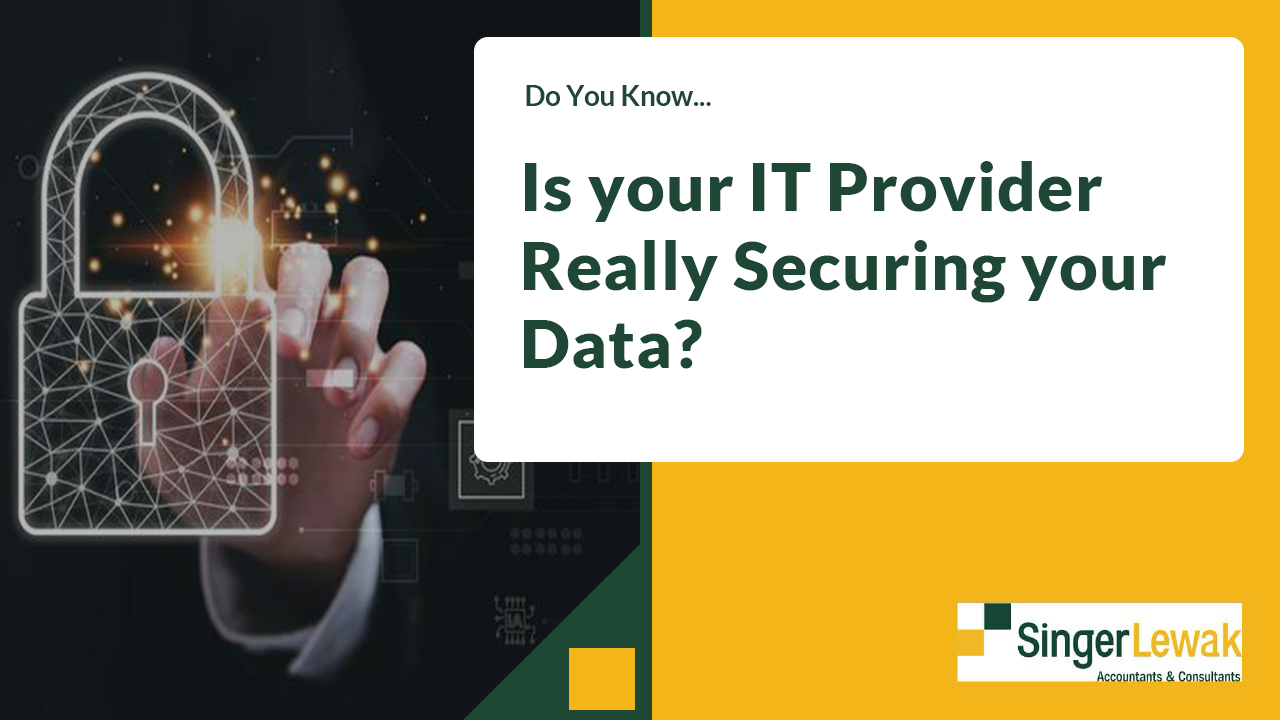Don’t be the next Cyber breach statistic just because you trusted your IT provider without validating their capabilities
Author: Carl Grifka
SingerLewak’s Cybersecurity professionals provide insights to help management team members and boards of directors navigate the growing threats in our Cyber-connected world. We have articles and other content available to help you learn more at singerlewak.com/cybersecurity.
In today’s evolving cyber landscape, relying solely on your IT provider’s assurances may leave dangerous blind spots in your defenses. Our top six questions that you should ask will help you uncover whether your provider is truly securing you data—and not just ticking boxes. From real-time vulnerability management to understanding independent SOC 2 audit reports, these points are designed to help you challenge your provider’s claims and help you ask for proof.
Real-Time Visibility & Transparent Reporting
Can you see every vulnerability and patch in real time?
If your IT provider doesn’t offer real-time vulnerability-management dashboards, you may be blind to emerging threats until it’s too late. These centralized dashboards empower you to prioritize and address risks proactively, rather than discovering breaches after the fact.
Are their reports truly transparent and comprehensive?
Quarterly summaries that gloss over pending issues, regardless of their actual importance, can lull you into a false sense of security. Demand detailed reporting that shows which systems are secured, which vulnerabilities are open, and exactly when patches were applied.
Proactive, Continuous Risk Assessments
Are they hunting threats around the clock?
Threat hunting isn’t a one-time activity—it’s an ongoing practice of proactively searching for hidden adversaries in your network. Without continuous threat hunting, stealthy attackers may dwell undetected, gathering intelligence and moving laterally.
Do they run frequent vulnerability scans, not just annual checks?
Periodic scans leave gaps wide open between assessments. Continuous vulnerability assessment tools and frequent reporting detect emerging threats in real time, ensuring you stay ahead of attackers.
Defense-in-Depth with Zero-Trust Principles
Is your perimeter firewall the only defense in place?
Relying on a lone firewall is like locking the front door but leaving every window open. In a Zero-Trust model—where “never trust, always verify” is enforced—every user and device must authenticate for each request based on their actual business need.
Have they layered multiple security controls around your critical assets?
Defense-in-depth goes beyond firewalls, incorporating network segmentation, endpoint protection, and strict access controls (including multi-factor authentication (MFA)). Each layer contains potential breaches, preventing attackers from moving freely across your systems.
24/7 Monitoring & Rapid Incident Response
Do they offer round-the-clock security-operations support?
Cyber-criminals don’t keep office hours—and neither should your defenders. A staffed, 24/7 Security Operations Center (SOC) is essential for spotting anomalies the moment they arise.
Is there a documented playbook ready for immediate action?
Detection without response is meaningless—verify that your provider has a tested incident-response plan detailing roles, communications, and containment procedures. Swift containment minimizes downtime, financial loss, and brand damage.
Compliance & Continuous Training
Are they keeping pace with evolving regulations—and training your team?
Frameworks such as SOC 2, ISO 27001, and HIPAA require robust controls and regular audits. Compliance isn’t a checkbox—it’s a commitment to maintaining best practices as threats and standards evolve.
Do they educate your staff on phishing, social engineering, and secure coding?
People are often the weakest link—regular security-awareness and secure-coding workshops transform employees into active defenders. Well-trained teams can spot and thwart common attack vectors that automated tools may miss.
Independent SOC 2 Reports: A Must-Have Assurance
Do they provide an unbiased SOC 2 report from a CPA firm?
SOC 2 reports, audited by accredited CPAs, validate the design and operating effectiveness of information security controls. Without this independent evidence, how can you trust that claimed safeguards truly work every time?
Are they leveraging SOC 2 to streamline your vendor assessments?
SOC 2 reports not only boost stakeholder confidence but also reduce the need for repetitive vendor questionnaires – and help you understand the controls that you need to have in place to safeguard your data, based on guidance from the vendor. By aligning with other frameworks like ISO 27001, SOC 2 accelerates compliance and cuts costs across your organization.
Take the Next Step
Still unsure if you have truly assessed your risk? Need help with assessing your Information Security / Cybersecurity “maturity” and preparedness? We’re here to help. We’ve got many years of experience helping businesses tune their Cybersecurity gameplans towards the risks and threats most impactful and likely to them.
Reach out to us at [email protected]
Or check out our web page for more information, articles, webinar announcements and learning eents: https://singerlewak.com/cybersecurity
Don’t wait for a breach to test your defenses—partner with SingerLewak LLP’s Cybersecurity Team today.



